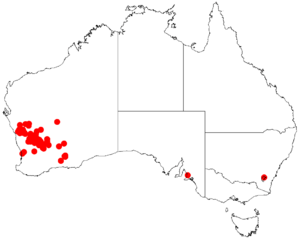Jibberding wattle facts for kids
Quick facts for kids Jibberding wattle |
|
|---|---|
| Scientific classification | |
| Genus: |
Acacia
|
| Species: |
jibberdingensis
|
 |
|
| Occurrence data from AVH | |
The Jibberding wattle (scientific name: Acacia jibberdingensis) is a special type of shrub or small tree. It's also sometimes called the willow-leafed wattle because its leaves look a bit like willow leaves. This plant belongs to the Acacia family and is found only in Western Australia.
What Does It Look Like?
This plant is usually slender and grows upright. It can reach a height of about 1.5 to 7 meters (5 to 23 feet). It can also spread out to about 5 meters (16 feet) wide.
Its branches are slightly hairy and have a bit of an angle. The leaves, called phyllodes, stay green all year. They are flat and long, like a line, and can be straight or slightly curved. These leaves are smooth (meaning they have no hairs) and are about 15 to 32 centimeters (6 to 13 inches) long. They are quite thin, only about 1 to 1.5 millimeters wide.
The Jibberding wattle blooms from June to October. It produces bright yellow, sweet-smelling flower-spikes. These flower-spikes grow one by one where the leaves meet the stem (this spot is called the axil). Each flower-spike is about 20 to 35 millimeters (0.8 to 1.4 inches) long and 6 millimeters (0.2 inches) wide. They are packed with golden flowers.
After the flowers, thin, smooth seed pods grow. They look a bit like a string of beads. These pods can be up to 21 centimeters (8 inches) long and 5 to 7 millimeters (0.2 to 0.3 inches) wide. Inside the pods, the seeds are shiny and black. They are arranged lengthwise and are broadly oval-shaped, about 4.5 to 5.5 millimeters (0.18 to 0.22 inches) long. Each seed has a small, pitted area called an areole.
How It Was Named
Scientists first officially described the Jibberding wattle in 1927. Two botanists, Joseph Maiden and William Blakely, gave it its scientific name. They wrote about it in a paper called Descriptions of fifty new species and six varieties of western and northern Australian Acacias. This paper was published in a science journal.
Later, in 2003, another botanist named Leslie Pedley changed its name to Racosperma jibberdingense. But then, in 2006, it was moved back to the Acacia group. The first plant sample used to describe the species, called the type specimen, was collected by M.Koch in 1960. It was found near Jibberding, close to Dalwallinu.
Where It Grows
The Jibberding wattle is native to certain parts of Western Australia. You can find it in the Mid West, Wheatbelt, and Goldfields regions.
It often grows near granite rocks in sandy, loamy soils. The plants are spread out from Mullewa in the north to around Peak Charles National Park in the south east. It mostly grows in areas with low shrubs and bushes, which are called shrubland communities.
Growing Jibberding Wattle
You can grow the Jibberding wattle from seeds. However, before you plant the seeds, they need to be treated. This process is called scarification, and it helps the hard seed coat to open up so the seed can sprout.
This plant grows best in soil that drains water well and in a sunny spot. It can also handle both frost (very cold temperatures) and drought (very dry periods) quite well.

